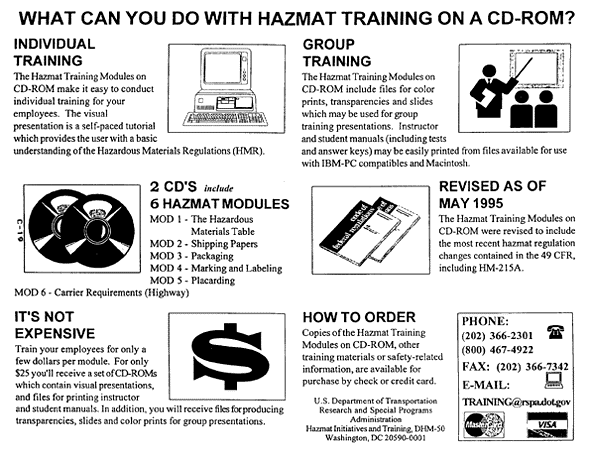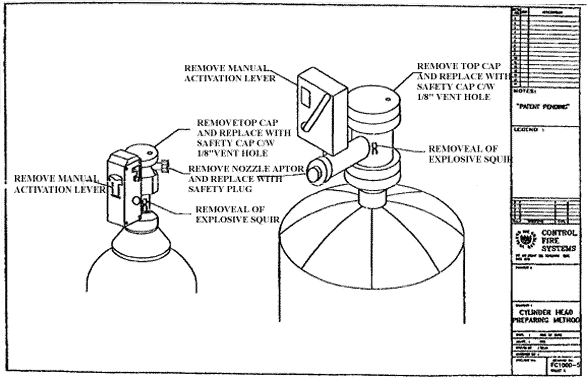
Appendix B: Sample
Shipping Procedures
for Halon 1301
provided by Control Fire Systems
1. PREPARATION
Have a clear understanding of the cylinder head assembly. Consult your fire service company, or Transport Canada office for assistance if necessary.
Each cylinder must be labeled with a "Class 2" green, hazard label with the PIN # UN 1009 clearly print on it. These labels Must also be affixed to the outside of each cylinder or crate, along with Material Safety Data Sheets.
2. SHIPPING
When preparing the cylinders for shipping, all units must be secured with metal stropping onto hardwood skids. Discharge port must be capped, manual activator removed, and explosive detonators disposed of. This will prevent any Injuries resulting from accidental discharges.
3. TRANSPORTATION
CP Express is our exclusive halon carrier, however, clients my use their preferred company. Orders shipped are to be marked prepaid, unless otherwise agreed upon by C.F.S.. Control Fire Systems shall not be responsible as to condition of goods, or the loss of any gases enroute. It is the responsibility of the shipper to acquire necessary insurance coverage on their shipments.
Bills of Lading are prepared indicating the following:
- Total number of cylinders.
- Total shipment weight overall.
- The type of agent being sent, i.e.
UN 1009 1301 Halon
Bromotrifluoromethane.
- This gas is non-flammable.
- The Dangerous Goods Class of 2.2.
- The emergency telephone number 1-800-363-1301.
- Ship to address, marked prepaid (unless otherwise agreed upon by C.F.S.).
4. CYLINDER DISPOSAL
All halon cylinder which have been depleted of halon shall be scrapped, and the metal recycled, unless otherwise advised by the client in writing.
Appendix C: Information
on U.S.
Department of Transportation (DOT)
Hazardous Materials Marking and Labeling
Provided by
Brooks Equipment Company, Inc

FC1000-5
SHEET 1
CONTROL FIRE SYSTEMS LTD
.Transportation And Preparation of Halon Cylinders
CONTROL FIRE SYSTEMS LTD.
63 ADVANCE: RE., BLDG.
"A"
TORONTO, ONTARIO M8Z 2S6
TELEPHONE: (416)236-2371
FACSIMILE:
(416)233-6814
|
Shipper(Name): |
Bill of Landing NO: | ||||
|
Consignee(Name) |
Carrier(Name): | ||||
|
Transport Details This shipment is strictly within the limitations prescribed for: LAND ----O
------SEA--- O
-------AIR
---O -----------RAIL -----O HALON 1301----O----- HALON
1211 ---O
-----------OTHER
--O |
CAUTION This shipment contains an ozone depleting | ||||
|
|
-------
YES --------------N/A | ||||
|
| ||||
|
Additional Handling Information and Special Instructions: |
CHEMICAL EMERGENCY NO. (24 HR.) | ||||
|
I, hereby declare, and undersign, as the shipper, that the contents of this consignment are fully and accurately described above by proper shipping name and are classified, packed, marked, and labeled. |
Name.Title of Shipper: Place and date: Signature------------------------------(Print) x_____________________________ Signature ------------------------------(Print) | ||||
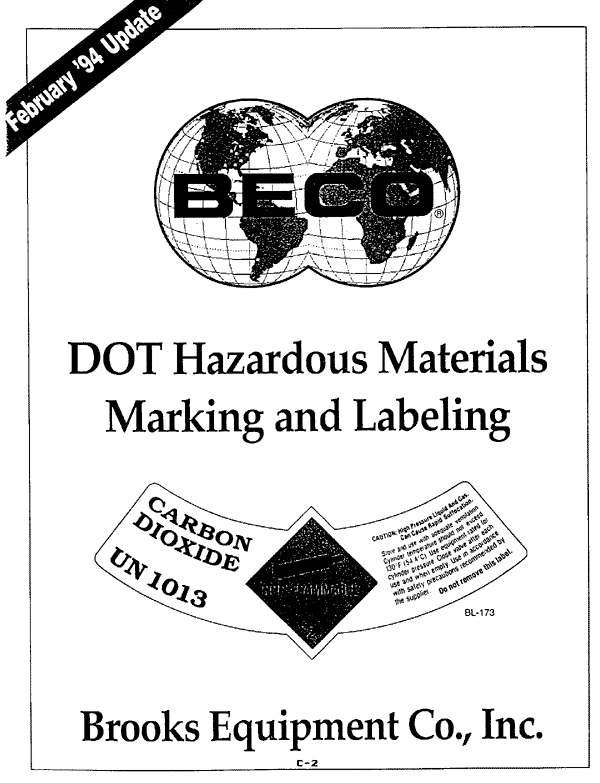
Confused by the Department of Transportation's regulations for transporting hazardous materials?
Heard rumors of changes to the regulations concerning transportation of fire extinguishers? Unsure if you have met the DOT requirements for hazardous materials training? You are not alone! We have attended seminars, consulted with consultants, and spoken directly with the DOT and we have heard different stories from each. And, because there has been no formal interpretation from the US DOT, we don't know how these regulations are being interpreted and enforced on the local level.
One thing that we know for sure is that the DOT is constantly writing and rewriting regulations for the transportation of hazardous materials. Although it is sometimes like trying to hit a moving target, Brooks Equipment is constantly monitoring the activities of the DOT to bring you the most up to date information that will have an impact on your business. We have done our best to come up with a number of cost effective supplies, based on these interpretations, that you need to be on the safe side of the current DOT requirements.
Remember that the only way to insure compliance with any DOT regulation is by obtaining and following the Code of Federal Regulations, 49 CFR parts 100-177 (Brooks parts number DOT1). Once you have a copy, you can use the references in this booklet to find the appropriate sections in the DOT regulations that apply to your business and training needs.
Brooks Part
#DOT1
Hazardous Materials Marking And Labeling
All packages or cylinders of hazardous materials that are transported or offered for shipment must be identified as hazardous materials. These are the hazards classes, identification ("UN") numbers, proper shipping names and labels for Brooks products and other common products.
REMEMBER: These marking and labels MUST appear on all packages or cylinders (unless exempted) that are transported or offered for shipment. Also, DOT requires all drivers to have a supply of labels to replace lost or destroyed labels on packages. (49 CFR part 177.815)
|
Hazard class |
"UN" Number |
Proper Shipping Name |
Label |
New (in the original box with original packings) dry chemical fire extinguishers
|
2.2 |
UN1044 |
FIRE EXTINGUISHER |
NON-FLAMMABLE GAS |
Carbon dioxide fire extinguishers, cylinders and nitrogen cartridges
-|
2.2 |
UN1013 |
CARBON DIOXIDE |
NON-FLAMMABLE GAS |
Dry chemical fire extinguishers and water extinguishers charged with nitrogen, nitrogen cylinders and nitrogen cartridges-
|
2.2 |
UN1066 |
NITROGEN, COMPRESSED |
NON-FLAMMABLE GAS |
Dry chemical and wet chemical
-|
2.2 |
UN1956 |
COMPRESSED GAS NOS (CHLORODIFLUOROBROMO-METHANE, NITROGEN |
NON-FLAMMABLE GAS |
1211 recharge cylinders (NOT charged with nitrogen)
|
2.2 |
UN1974 |
CHLORODIFLUORO- BROMOMETHANE |
NON-FLAMMABLE GAS |
Halon 1301 system cylinders (charged with nitrogen) -
|
2.2 |
UN1956 |
COMPRESSED GAS, NOS (BROMOTRIFLUORO METHANE,NITROGEN) |
NON-FLAMMABLE GAS |
Halon 1301 recharge Cylinders (NOT charged with nitrogen)
|
2.2 |
UN1009 |
BROMOTRIFLUORO METHANE |
NON-FLAMMABLE GAS |
Water fire extinguishers charged with air, SCBA and SCUBA cylinder and compressed air
-|
2.2 |
UN1002 |
AIR COMPRESSED |
NON-FLAMMABLE GAS |
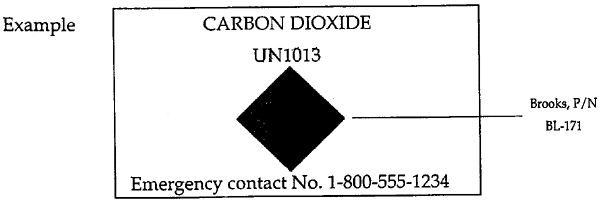
You can draw the markings on the packages (see example) but you must use a green printed diamond label (like Brooks part number BL-171 "Non-Flammable Gas") for packages containing non-flammable gases. See 49CFR part 172.101.
Optional Markings For Compressed Gas Cylinders
All compressed, gas cylinders must be marked according to DOT specifications. It is permissible to mark these cylinders with a single label or tag (labels and markings for compressed gas cylinders may be placed on securely affixed tags per 49 CFR 172.304 and 172.406) that includes the following information:
You can use Brooks "neck" labels or new "compressed gas repair tags" to properly mark carbon dioxide, nitrogen, compressed air, Halon 1211 and 1301 cylinders. SEE EXAMPLES ON PAGE 3
Also, the name of the chemical manufacturer, importer, or company that filled or is responsible for the cylinder must be included on the cylinder or label. See 49 CFR part 172.400 and CGA (Compressed Gas Association) pamphlet C-7 Appendix A.

Hazardous Materials Shipping Papers
All hazardous materials that are transported or offered for shipment must be accompanied by shipping papers that indicate that the materials are hazardous.
If you are carrying hazardous materials in your service truck (including fire extinguishers) to or from a work site you must have shipping papers that at all times are "readily available to, and recognizable by, authorities in the event of accident or inspection" (49 CFR part 177.817). Brooks part number HMSP50 is a pad of 50 pre-printed daily hazardous material shipping papers.
Also available is Brooks part number HMSP-DE, which is a reusable, "wipe-off" form which is easily changed at each pick-up or delivery. Use permanent markers (Brooks part number PMP or PMF) to fill in your company name and red dry erase pens (Brooks part number RDEP) or green dry erase pens (Brooks part number GDEP) to change the quantity of hazardous materials carried.
If you offer a hazardous material for shipment you must use the shipping papers required by that carrier. For UPS air and ground shipments there are special forms that must be obtained from UPS. Forms for motor freight can be obtained from the air cargo companies. Air express carriers such as Federal Express and others use their own special forms. Check with the carriers, these forms are sometimes provided free of charge. Pre-printed forms (which include your company name and other information of your choice) can be purchased from several suppliers.
Even some materials that are not considered "hazardous" must have special shipping papers that show them as non-hazardous. For example, the dry and wet chemicals must be indicated on a special "NOT RESTRICTED" form and must show the principle ingredient. When these materials are carried on a service truck it is a good idea to show them as non-hazardous on your shipping papers and to carry the MSDS in case of an accident or inspection. Having these may greatly reduce the time and expense of your truck sitting idle that would result from a DOT official wanting proof that they are not hazardous materials.
REMEMBER: Any material listed above or that has a "UN" number associated with it will need shipping papers to accompany it when it is offered for shipment or is transported. See 49CFR parts 172.200-172.205, parts 172.600-172.604 and part 177.817.
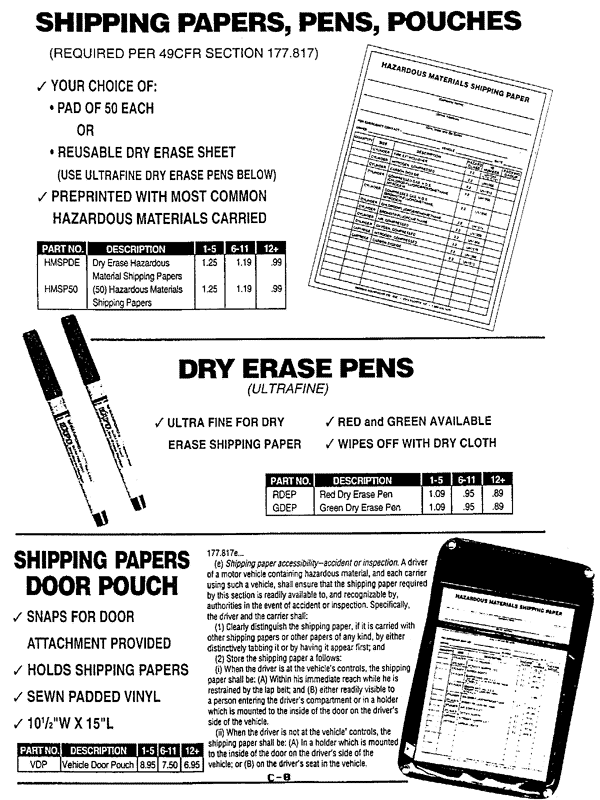
Material Safety Data Sheets (MSDS)
Service trucks that carry hazardous materials (either being transported to the customers' location or that are used in the service truck and on the job sites) must carry either a copy of the Material Safety Data Sheet (MSDS) for each hazardous material or the DOT Emergency Response Guidebook that covers all hazardous materials (Brooks part number ERGB). Either the MSDS or the Guidebook must be kept with the hazardous materials shipping papers and separate from the hazardous materials. MSDS are available upon request for all Brooks hazardous materials.
See 49CFR part 172.602.
REMEMBER: Emergency response information must be readily available to responders in the event of an accident or emergency and also available to DOT officials during an inspection. Order a Guidebook for each truck to be sure!
Emergency Response Number
AR shipping papers, including those carried in a service truck, must have an emergency response number printed, stamped or written on them. (Some carriers require the emergency response telephone number to be on the packages in addition to the shipping papers.) When hazardous materials are shipped, this telephone number must be staffed 24 hours per day, 365 days per year by persons that can respond immediately to questions about the hazardous materials in the shipment. See 49CFR part 172.604.
There are several services available that will be able to provide your company with this service. They are:
|
Fire Protection Consultants |
202-835-0272 |
|
CHEMTREC |
202-887-1255 |
|
CHEMTEL |
813-979-0626 |
|
INFOTRAC |
800-535-5053 |
NOTE: There is a fee for this service and you may be required to provide MSDS for all hazardous materials that you are transporting or offering for shipment.
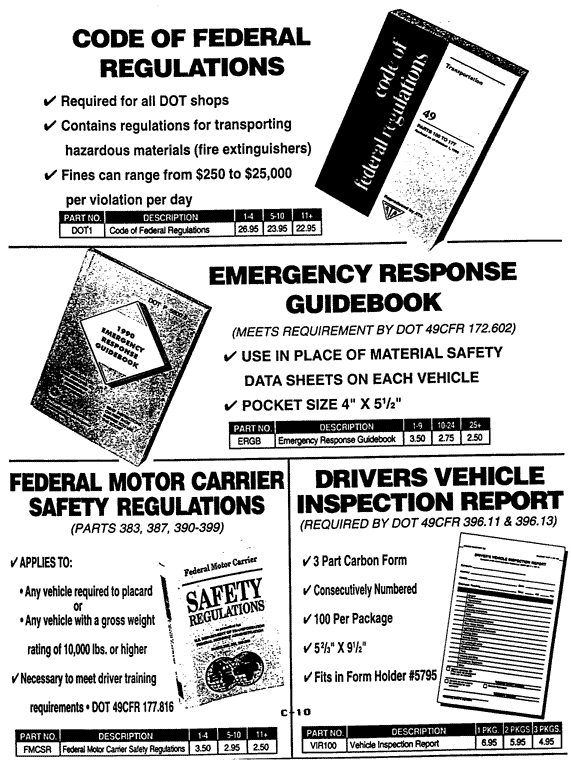
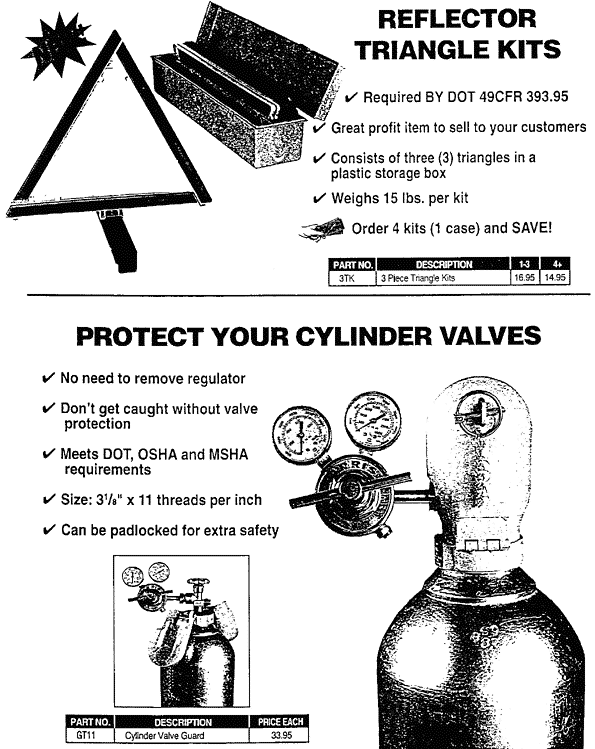
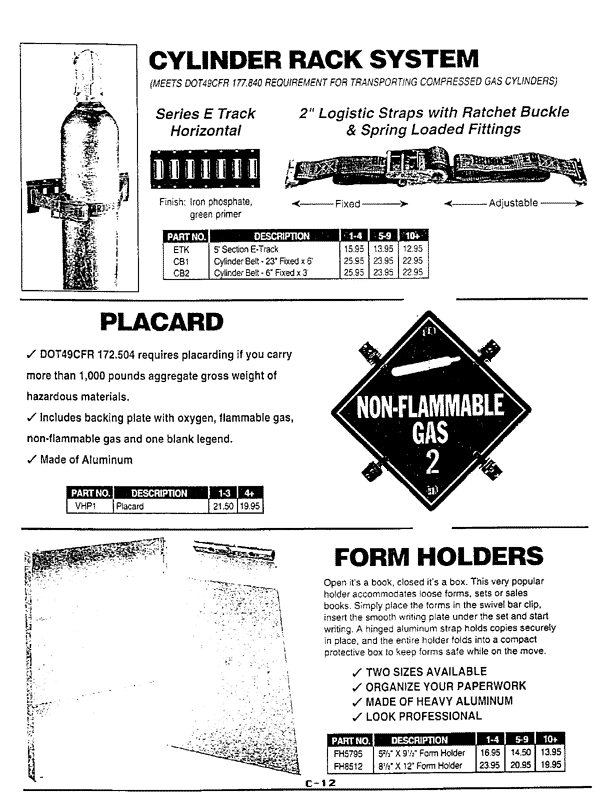
Important Telephone Numbers
|
Brooks Equipment Co., Inc. |
800-826-3473 |
|
United States Department of Transportation: |
202-366-4000 |
|
U.S. DOT Office of Hazardous Materials Initiatives and Training: |
202-366-4900 |
|
(For training resources) |
202-366-2301 |
|
U.S. DOT Office of Hazardous Materials Standards: |
202-366-4488 |
|
U.S. DOT Office of Hazardous Materials Enforcement: |
202-366-4700 |
|
Compressed Gas Association: |
703-412-0900 |
|
(To order CGA pamphlets) |
Safety Considerations For Shipping Or Transporting Compressed Gas Cylinders
All cylinders that are shipped or transported must be properly prepared and secured for transportation.
Examples of proper loading include lashing in an upright position, (call for prices on Brooks "E" track strapping system) loading into securely attached racks, packing in boxes or crates sized to prevent their overturning or horizontal loading. In addition, cylinders must be loaded to minimize the possibility of damage to their valves. See 49 CFR parts 177.834 and 177-840.
According to 49 CFR part 173.301, all cylinders containing flammable, corrosive or noxious compressed gases must be shipped with the valve protected against damage. The Brooks valve guard (part number GT-11) is ideal for cylinders where it is desirable to keep the regulator attached and still protect the valve at all times (for example, on the nitrogen cylinder used for recharging fire extinguishers in your service trucks), Commercial aluminum carbon dioxide cylinders may be shipped with carry handles that also serve as valve protectors. Use Brooks part number CCH (with CCH-Ring) on Luxfer aluminum cylinders and CCHK (with CCHK-Ring) on Kidde aluminum cylinders.
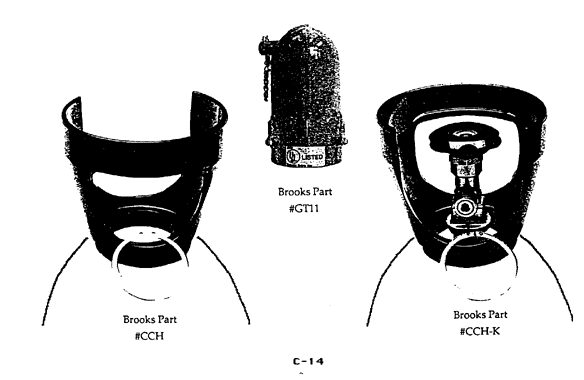
TRAYING OUTLINE
HM-126F
General Awareness and Familiarization Training
1. Introduction
- Review definitions and DOT requirements for training
- Review who requires training
- Review the nine hazard classes and their divisions. Stress the hazard classes that your operation is the most involved in.
2. Hazardous Material Table (Section 172.101)
- The table lists the materials that the DOT has determined, "may pose an unreasonable risk to health and safety or property when transported in commerce". The table provides the requirements for shipping hazardous materials.
- Explain that the training will provide the shipping information for the materials that are normally handled by the company. If an employee is not sure about a specific material they should contact someone in authority who can look the material up in the table.
3. The use of shipping papers
- Review the fines issued by the DOT for improper shipping papers.
- Review the proper format for the shipping paper.
- Entries must be printed in English.
4. Proper labeling and marking of non-bulk hazardous materials
- The proper label is required on all cylinders and packages of hazardous materials being transported. The label is the diamond with the proper wording and symbols.
- Markings identifying the contents by proper shipping name and number must be on each package.
- The CGA style cylinder label meets the requirements for the products that we normally transport.
- Most new fire extinguishers in their boxes are exempted from labeling.
- DOT specifications cylinders must be properly stamped as part of their markings.
5. Proper loading and storage techniques
- Review the "Hazardous Materials Load and Segregation Chart".
6. Proper Placarding
- Explain the different placards that may be require for your operation.
- Placards are required for loads of 1001 pounds or more aggregate gross weight of hazardous materials.
- If your policy is not to placard review actions that can be taken to limit weight of hazardous materials. This can include removing cartridges from extinguishers and pre-engineered systems, and removing the nitrogen cylinder from wheeled units.
- Remember that "Limited Quantity" Fire Extinguishers, UN1044, are exempted from placarding when properly identified on the shipping paper.
7. Dealing with hazmat emergencies
- What emergency response phone should be used?
- How to properly use a fire extinguisher.
- Is a list of emergency phones numbers available?
- Where is emergency response information kept?
- Review the Emergency Response Guidebook
Function Specific Training
Function specific training is intended to teach the skills for a specific hazardous materials job function. For our industry this can be everything that a service technician does. This training must be geared for your specific operation and must include training for drivers for all of their non-driving duties. Some of the areas that need to be reviewed include:
- Proper load securement in vehicles
- Proper storage of materials in the shop
- Hydrostatic testing procedures and requirements
- Correct filling procedures
- Shipping papers
- Placarding requirements
- Proper package marking
- Handling of compressed gas containers
- Review the proper way to fill out a Bill of Lading
- Verify hydrostatic test dates
- Verify cylinder compatibility with the agent and/or gas used in recharging.
- Review the requirements for proper shipping containers for hazardous materials that you transport, eg. gasoline
Safety Training
1. Safety training must be provided to ensure that employee knows how to respond to a hazardous material emergency. This training is not intended to make an employee a hazardous materials response expert.
2. Include basic safety training for all employees
- How to use a fire extinguisher
- Whom to call in case of emergency
- Review the importance of properly handling compressed gas cylinders (fire
extinguishers).
3. Review the Emergency Response Guidebook
- Yellow Pages list hazardous materials by ID number
- Blue pages list
hazardous materials alphabetically
- Orange pages contains the emergency
response information listed by guide number
- Green pages contain the initial
isolation and protective action distances
4. Review the personal protective equipment provided or required by your company
- This includes such items as safety shoes, hard hats, back belts, respirators, safety glasses, self contained breathing apparatus, etc.
5. Discuss your company's emergency response plans
- Do all employees know whom to contact in case of an emergency?
- Do you have a building evacuation plan?
- What are employees supposed to do if a cylinder is leaking?
- Review common safety practices
- Avoid inhalation of fumes or gases from any cylinder
- Review location of MSDS for your operation
Driver Training
1. Introduction
- Review that drivers are responsible to comply with federal and local driving regulations
2. Pre-trip safety inspections
- Safety starts before you turn on the key
- The purpose of a pre-trip inspection is to find any defect or problems that could affect the safe operation of the vehicle
- Tires must be inspected before every trip (in addition vehicles with dual tires must inspect the tires every two hours or 100 miles, whichever comes first).
3. Vehicle operation and controls
- Do all of the vehicle controls work properly?
- Verify that each vehicle has warning reflective triangles, My charged and properly rated fire extinguisher, an Emergency Response Guide, and a properly prepared shipping paper with an emergency response phone number.
4. Vehicle operation
- Review driving basics such as turning, backing, parking and other expected road conditions.
- Review procedures for adverse driving conditions, such as wet pavements, standing water, snow and ice, etc.
- Review parking and railroad grade crossing regulations
- The driver must be attendance and the engine must be off when the vehicle is being fueled
5. Smoking
- No smoking is permitted on or within 25 feet of any vehicle carry explosives, flammable or oxidizers
- Review the company procedure for the reporting of accidents
6. Loading and Unloading
- Review the Load and Segregation Chart
- Review requirements for the proper securement of loads of hazardous materials
7. Driver's Vehicle Inspection Report
- Review the requirement for a written daily vehicle inspection report
8. Driver's Log
- If required by your operation, review the driver's daily time log requirements.
